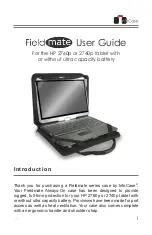
User’s Manual
Glossary-9
Glossary
I/O devices:
Equipment used to communicate with the computer and
transfer data to and from it.
I/O:
Input/output. Refers to acceptance and transfer of data to and from a
computer.
icon:
A small graphic image displayed on the screen or in the indicator
panel. In Windows, an icon represents an object that the user can
manipulate.
input:
The data or instructions you provide to a computer, communication
device or other peripheral device from the keyboard or external or
internal storage devices. The data sent (or output) by the sending
computer is input for the receiving computer.
instruction:
Statements or commands that specify how to perform a
particular task.
interface:
1) Hardware and/or software components of a system used
specifically to connect one system or device to another. 2) To
physically connect one system or device to another to exchange
information. 3) The point of contact between user, the computer,
and the program, for example, the keyboard or a menu.
interrupt request:
A signal that gives a component access to the
processor.
IrDA 1.1:
An industry standard that enables cableless infrared serial data
transfer at speeds of up to 4 Mbps.
K
K:
Taken from the Greek word kilo, meaning 1000; often used as
equivalent to 1024, or 2 raised to the 10th power.
See also
byte and
kilobyte.
keyboard:
An input device containing switches that are activated by
manually pressing marked keys. Each keystroke activates a switch
that transmits a specific code to the computer. For each key, the
transmitted code is, in turn, representative of the (ASCII) character
marked on the key.
kilobyte (KB):
A unit of data storage equal to 1024 bytes.
See also
byte
and megabyte.
L
L1 cache:
Level one cache. Memory cache built into the processor to help
improve processing speed.
See also
cache memory, L2 cache.
L2 cache:
Memory cache installed on the motherboard to help improve
processing speed. It is slower than L1 cache and faster than main
memory.
See also
cache memory, L1 cache.









































